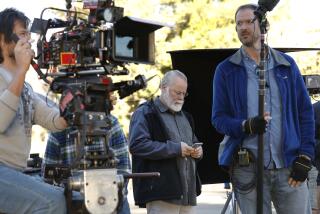(Way) Back Pay
A Studio City bar called Residuals used to give a free drink to any actor carrying a residual check worth less than $1. It was a charming tradition that came to an end about five years ago, when the liquor control board got wind of bartenders giving booze away.
But these days, many members of the Screen Actors Guild say they’d be delighted to take that tiny residual check, as long as it got to them on time.
Millions of dollars’ worth of residuals due to actors are stashed in a walk-in closet on the seventh floor at the SAG offices on Wilshire Boulevard. Some, like the ones for the late Nacho Galindo, have gone unclaimed since he died in 1973. Others sit in a backlog of SAG bureaucracy for months at a time. Residual payments are filed four times a year by producers of television shows or movies for rebroadcast in venues that range from worldwide syndication to pay TV. These quarterly batches of residuals arrive at SAG en masse, and last year the union received 1.3 million checks totaling $385 million, according to the union’s chief executive officer, Bob Pisano.
The union, which processes the payments by hand, said it hopes to have the system computerized soon. Meanwhile, it admits to a “slight backlog” but said it cannot quantify the extent of the problem. It estimates that 1% of the checks--totaling about $2.8 million last year--are for actors it cannot locate.
For some actors, the wait for checks can be excruciating, even by the hand-to-mouth standards of the trade.
Residuals for Holly Dorff, who has appeared in dozens of television shows and movies as a background voice--a “looper”--bring her $60,000 to $70,000 a year. Most recently, she looped “Minority Report.” It is crucial income for the single mother of a 3-year-old autistic child who rents a two-bedroom apartment in Studio City.
But last summer, when her child was being diagnosed and she wasn’t working, her residuals stopped. SAG sent one payment to her 100 days after the studio had cut the check, a quarter late.
“They said there were fixing the problems,” she said of the 98,000-member guild. “I want to organize a boycott of my union dues. Everyone else’s bank is earning interest on our money. You’re talking about thousands of dollars sitting in an account that don’t get cashed.”
In protest, Dorff has not paid her union dues, about $1,776 a year, since last November. “Why should we pay the residual department salaries with our dues until they send us our checks? What they’re doing is wrong and illegal,” she said. “I’ve been living hand to mouth. I shouldn’t have to live this way, because the money owed to me is sitting there.”
Paige Pollack, a voice-over actress and foley artist who worked most recently on NBC’s “Scrubs,” just cashed a check from January. “The residuals are all late,” she said.
SAG said the system will be computerized in the next four to eight months. In the meantime, the residuals department--a handful of full-time staff manually entering and recalculating each and every check--recently eliminated one step in the process.
Three weeks ago SAG alerted members that it would withhold the name of the specific production for which the actor was receiving the check, which would expedite the process. SAG promises to mail out a breakdown of the payment within 60 days.
“I’d rather them have the money and get the information later,” Pisano said.
But Dorff said this will only complicate things for recipients trying to keep track of their payments from various projects. She said she finally threw up her hands when her complaints were met with a call from a SAG representative who urged her to dip into the emergency fund for actors, called the Motion Picture Fund, until her residual check arrived.
By this time next year, Pisano hopes to send checks to actors with up-to-date information within 30 days of receiving the money.
The frustration for members of SAG seems unparalleled in the other unions, mainly because of the numbers. Neither the Writers Guild of America nor the Directors Guild of America is responsible for so many residual recipients.
Not everyone finds SAG’s system bad news. While Dorff waits for her checks, Marlo Brawer says she feels as if a gift has fallen out of the sky.
Brawer was never enrolled in SAG, and she is not a professional actor. Ten years ago, she had started work at a television station in Medford, Ore., when Universal Pictures began shooting the action drama “The River Wild,” starring Kevin Bacon and Meryl Streep.
Brawer was hired at the standard day rate then, about $500, to play a young television reporter. Her scene ended up on the editing room floor, replaced by the voice of a male radio reporter. She was still thrilled to see the film and, over the next decade, kept busy by working in television journalism and going to law school at night.
Last spring, she decided to use her background as a springboard to break into dramatic TV scriptwriting, and on her final day at a television station in Oklahoma City last month, she was surfing the Internet, dreaming about moving to L.A.
“I popped on the Screen Actors Guild Web site just to see what was going on out here,” she said. “I saw a link to ‘unclaimed residuals.’ I clicked on it and typed in my last name for fun.”
Under the link to “SAG ‘Missing,’ ” Brawer’s full name appeared, and she immediately called SAG, only to discover it was holding 10 years’ worth of unclaimed residuals sitting in trust that totaled about $815.31. Brawer has moved five times since “The River Wild” was filmed, and she never thought to update her Oregon address.
She picked up her check one week after she learned the money was waiting for her. “It’s not a lottery windfall, but to me, who recently quit my job to pursue my dream, money is money.”
In all, more than 45,000 names are posted on SAG’s Web site under “missing” performers, and a SAG representative expressed hope that more people would click on to the Web site as Brawer did.
“We’re only as good as the information they provide the guild,” said national spokeswoman Ilyanne Kichaven.
“We have members who do one thing and then they decide not to act anymore, and the movie is shelved and at some point is shown, although they don’t know it.”
More to Read
The biggest entertainment stories
Get our big stories about Hollywood, film, television, music, arts, culture and more right in your inbox as soon as they publish.
You may occasionally receive promotional content from the Los Angeles Times.










